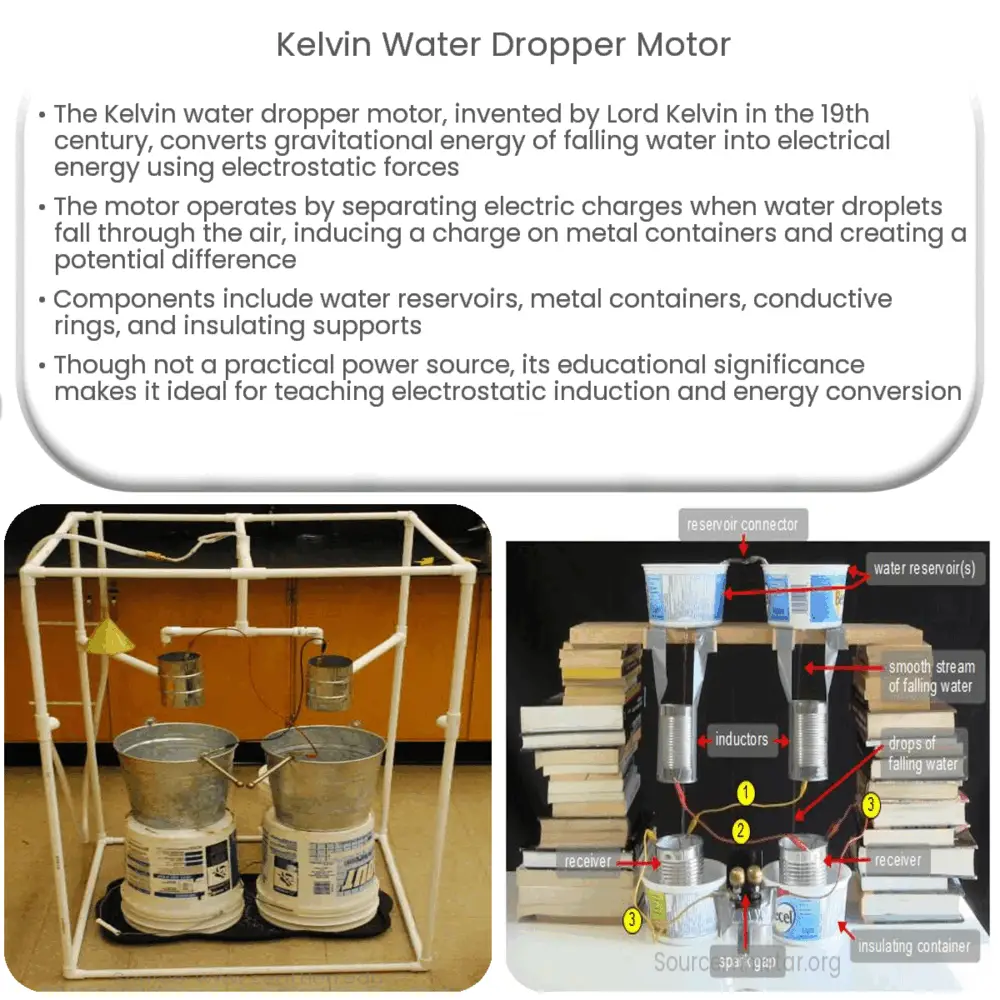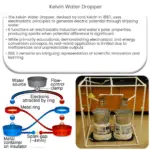The Kelvin water dropper motor is a device that converts gravitational potential energy of falling water droplets into electrical energy through electrostatic forces.

Kelvin Water Dropper Motor: Harnessing Electrostatic Energy
Introduction
The Kelvin water dropper motor, also known as the Kelvin electrostatic generator or Lord Kelvin’s thunderstorm, is a fascinating device that demonstrates the principles of electrostatic induction. Invented by the Scottish scientist William Thomson, also known as Lord Kelvin, in the late 19th century, this ingenious device converts the gravitational potential energy of falling water droplets into electrical energy through electrostatic forces.
Principle of Operation
The basic principle of the Kelvin water dropper motor relies on the separation of electric charges using the process of electrostatic induction. In simple terms, the dropper motor generates an electrical potential difference (voltage) between two metal containers by using the natural separation of positive and negative charges that occurs when water droplets fall through the air.
When water droplets are exposed to air, they tend to acquire a slight positive or negative charge due to the interaction between the water molecules and the surrounding air molecules. As the charged droplets fall into the metal containers, they induce an opposite charge on the container walls, thus creating a potential difference between the two containers. When this potential difference becomes large enough, it can create a spark that jumps between the containers, effectively discharging the accumulated electrical energy.
Components of a Kelvin Water Dropper Motor
A typical Kelvin water dropper motor consists of the following main components:
- Water Reservoirs: Two water reservoirs are placed at a certain height, with small holes or nozzles at the bottom to allow water to drip from them. These reservoirs are usually made of plastic or glass, as they need to be electrically insulating.
- Metal Containers: Two metal containers or buckets are placed below the water reservoirs to collect the falling droplets. The containers should be made of a conductive material, such as copper or aluminum.
- Conductive Rings: Two conductive rings or loops are suspended above the metal containers, positioned so that the water droplets pass through them before falling into the containers. The rings are connected to the opposite metal container, creating a cross-connection that allows for charge accumulation and potential difference generation.
- Insulating Supports: The entire setup is mounted on insulating supports, such as wooden or plastic stands, to prevent any unintended discharge of the accumulated electrical energy.
Applications and Significance
While the Kelvin water dropper motor is not a practical source of electrical power, it serves as an excellent educational tool for teaching the principles of electrostatic induction and energy conversion. Moreover, it has historical significance as one of the earliest electrostatic generators, predating the more well-known Van de Graaff generator by several decades.
Building a Kelvin Water Dropper Motor
Constructing a Kelvin water dropper motor can be a fun and engaging DIY project for students, hobbyists, or anyone interested in learning about electrostatic induction. The following steps outline a simple approach to building a functional dropper motor:
- Prepare the water reservoirs: Obtain two plastic or glass bottles with small holes or nozzles at the bottom. The size of the holes should be adjusted to produce a steady stream of droplets.
- Assemble the metal containers: Choose two conductive containers, such as small metal buckets or bowls made of copper or aluminum.
- Set up the conductive rings: Fashion two conductive rings or loops from copper wire, making sure they are large enough for the water droplets to pass through easily. Suspend the rings above the metal containers using insulating supports.
- Establish the cross-connections: Connect one conductive ring to the opposite metal container using insulated wires. This forms the crucial cross-connection that enables charge accumulation.
- Mount the setup on insulating supports: Ensure that the entire assembly is mounted on insulating supports, such as wooden or plastic stands, to prevent any unintended discharge of electrical energy.
- Fill the reservoirs and start the dropper motor: Fill the water reservoirs and allow the droplets to fall through the conductive rings into the metal containers. As the potential difference builds, you should eventually observe a spark jumping between the containers.
Troubleshooting and Enhancements
If you encounter difficulties in generating a spark, consider checking the following aspects of your setup:
- Ensure that the droplets are falling consistently and that the hole sizes in the water reservoirs are appropriate.
- Verify that the conductive rings are properly aligned, allowing droplets to pass through them without obstruction.
- Check the connections between the conductive rings and metal containers, ensuring they are secure and insulated.
For those interested in enhancing the performance or educational value of their Kelvin water dropper motor, consider experimenting with different materials, droplet sizes, or container configurations. You can also try adding a capacitor to store the generated electrical energy, or measure the voltage and current generated by the device using a multimeter.
Conclusion
The Kelvin water dropper motor is a captivating device that showcases the principles of electrostatic induction and energy conversion in a tangible and visually engaging manner. While it may not be a practical source of electrical power, its historical significance and educational value make it a worthwhile project for those interested in exploring the wonders of electricity and electrostatics.



